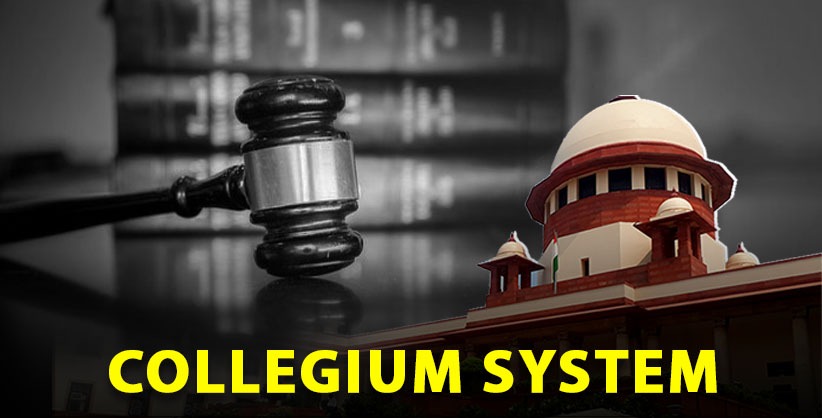By Ritabh Singh, 4th Year Law Student, Government Law College, Mumbai,
ritabhsingh44@gmail.com | February 02, 2023
THE COLLEGIUM SYSTEM AND THE ROLE OF THE COLLEGIUM
The recent battle of words between the executive and the judiciary finds its genesis in the ever controversial topic, i.e, the collegium system.
The Chief Justice of India (CJI), along with the four senior most puisne judges of the Hon’ble Supreme Court of India, form the collegium, and this body carries out the administrative function of recommending judges for appointment to the Supreme Court and the High Courts in India, and transfer of judges of the latter.
Only the collegium can initiate the process of appointment and transfer of judges and it recommends the names of suitable individuals for the appointment or transfer to the Council of Ministers. The collegium independently initiates this process as and when required.
The collegium only takes decisions of appointment and transfer for the constitutional courts, i.e, the Supreme Court and the High Courts. Judges of the District Courts are appointed by the Governor of the State in consultancy with the High Court of the State [1].
It is imperative to note that this system to appoint and transfer judges to the constitutional courts is not mentioned in any provision of law and has come into existence on account of past judgements of the Apex Court.
ROLE OF COUNCIL OF MINISTERS AND THE PRESIDENT OF INDIA
The names for appointment and transfer are recommended by the collegium to the Council of Ministers, who then aid and advise the President on the final appointment or transfer [2] of judges. The President is bound to exercise this function in accordance with the advice given by the Council of Ministers. Judges are then appointed or transferred by the President under his hand and seal [3]. The collegium does not directly recommend names to the President. In a scenario where the made recommendation is not accepted by the Council of Ministers, the recommendation is sent back to the collegium for reconsideration. However, if the same names are recommended again by the collegium, the Council of Minsters is bound to accept those recommendations and to advise the President to appoint or transfer the judges accordingly.
CONSTITUENT ASSEMBLY DEBATES ON APPOINTMENT
In the pre-constitution era, judges were appointed at the absolute discretion of the Crown [4], subject only to criteria of eligibility. Judges also held office till the Crown’s pleasure [5]. The age limit for retirement of judges was introduced in The Government of India Act, 1935 [6]. During the drafting of our constitution, it was agreed by the Constituent Assembly that appointment must not be left to the executive, which is why a mandatory obligation to consult the CJI was put in place. Several recommendations for the appointment and transfer of judges were made such as constituting a board of members to appoint judges; to subject confirmation of appointment by two-third votes of Parliament; to consult Council of States for appointment. The debates, which lasted a week, resulted in the enactment of Article 124 of our constitution [7], and a consultative process for appointment and transfer originated between the executive and the judiciary.
THE THREE JUDGES CASE
After our Constitution came into force, judges were appointed by the President as per the advice of the Council of Ministers, however, subsequent to the consultation with the CJI, who was the senior most judge of the Supreme Court. Primacy in appointment, per se, did not vest in any functionary as decisions on appointment and transfer were taken after following a consultative process. The CJI did not enjoy the power to appoint or transfer judges, the President only appointed or transferred judges on advice of the Council of Ministers, and the Council of Ministers consulted and concurred with the CJI on appointment and transfer of judges. However, in 1973, Justice A. N. Ray [8] was made the CJI after superseding 3 senior judges. In 1977 again, Justice Khanna was superseded [9] due to the scathing remarks he made against the government [10] of the day. Prior to these 2 supplants, Prime Minister Nehru in the year 1964 appointed Justice Gajendragadkar as the CJI, superseding Justice Imam, the reason being that Justice Imam was suffering from a serious illness [11]. However, this was done after proper consultation took place between the Council of Ministers and the CJI.
As the consultative process broke down in 1973 and 1977, questions on primacy in appointment and transfer of judges arose, and the same was first decided in S. P. Gupta v. Union of India [12] (also known as the First Judges Case). Justice Bhagwati, in the case, held –
“The Chief Justice of India, the Chief Justices of the High Courts and such other Judges of the High Courts and of the Supreme Court as the Central Government may deem it necessary to consult, are merely constitutional functionaries having a consultative role, and the power of appointment resides solely and exclusively in the Central Government…
It would therefore be open to the Central Government to override the opinion given by the constitutional functionaries required to be consulted and to arrive at its own decision in regard to the appointment of the judge in the High Court or the Supreme Court…. Even if the opinion given by all the constitutional functionaries consulted by it is identical, the Central Government is not bound to act in accordance with such opinion…”
Thus, primacy rested in the opinion of the executive as held in the above mentioned case. It was held in the First Judges Case that since the executive is accountable to the public, primacy in appointment and transfer must be with the executive. Concurrence with the opinion of the CJI was held not to be a pre-requisite in appointment or transfer of judges by the Council of Ministers. The question of primacy and concurrence was re-visited in SCARA v. Union of India [13] (also known as the Second Judges Case) wherein the Supreme Court overruled the judgement of the First Judges Case.
The Court held that the provision for consultation with the CJI was introduced since it was realized that the CJI is best equipped to assess the worth of the candidate and his or her suitability for appointment as a judge. While the appointment must be a result of a participatory consultative process, in the event where there is an impasse due to disagreement between constitutional functionaries, the opinion of judiciary, which is symbolized in the opinion of the CJI, has primacy. Since personal traits of members are best known by the CJI, opinion of the CJI will not only have primacy, but will be determinative in the process of appointment and transfer. It was also held that the senior most judge of the Supreme Court shall be appointed as the CJI.
The Court held that the notion of the judiciary not being accountable to the public is a myth and has no real basis. In actual practice, the CJI and the Chief Justices of High Courts are held accountable for proper functioning of their courts and appointments made to their courts, not only by the public but even by the Bar. In response to the argument that provisions of the Constitution must be restricted to the interpretation which the framers intended, the court held that the current issue was not foreseen and therefore, was not discussed by the framers of the Constitution. The term ‘consultation’ in Article 124 of the Constitution was held to be understood as ‘concurrence’, meaning that the Council of Ministers are bound to concur with the opinion of the CJI in matters of appointment and transfer of judges. The Court went on to accept formation of a collegium, as the same was held more credible, and this collegium consisted of the CJI and the two senior most puisne judges of the Supreme Court. The primary function of this collegium would be to recommend names of suitable individuals for appointment and transfer in the constitutional courts to the executive. The executive had the option of refusing such recommendations after providing reasons to the collegium. However, if the same name was recommended again by the collegium, then the executive would be bound to accept such recommendation and appoint or transfer the individual.
In the Special Reference by the President, in exercise of authority granted by the Constitution of India, in 1998 [14] (also known as the Third Judges Case), the Supreme Court increased the number of senior most puisne judges in the collegium from two to four. It was a judgement which furthered the decision laid down in the Second Judges Case.
THE NATIONAL JUDICIAL APPOINTMENT COMMISSION
The National Judicial Appointment Commission (NJAC) Act was passed in 2014 which sought to introduce a body consisting of the CJI, two senior most puisne judges of the Supreme Court, the Law Minister and two eminent individuals (appointed by the CJI, Prime Minister and the Leader of Opposition), which would appoint and transfer judges in the constitutional courts. It sought to abolish the collegium system and to bring in transparency in the process of appointment and transfer of judges.
The Supreme Court held the NJAC Act as unconstitutional in 2015 [15]. The basis on which the Court held the Act as unconstitutional was the judgement passed in the Second Judges Case. The Court further held that the Act interfered with the independence of the Judiciary and would give primacy in appointment and transfer of judges to the political parties of the country. Since then, the Supreme Court has invited suggestions to improve the collegium system, and in 2017, the collegium publically uploaded its recommendations for appointment and transfer, along with reasons for the same. Recently, the collegium has even publically provided rebuttals to the objections raised by the executive, as seen in the appointment of Advocate Saurabh Kripal and Advocate Somasekhar Sundaresan, among others. However, arguments for right to reputation emerged, which remains imperative to consider.
CONCLUSION
The problems associated with the collegium system that had come to light was the cavalier attitude shown towards nepotistic elements and the total enigma surrounding the rationale behind appointments and transfers. It is unconscionable to have certain individuals exercising unfettered power. The consultative process must be followed to ensure cohesive constitutional functionaries. Independence of Judiciary is indeed of paramount importance, but the very purpose of democracy is defeated if only certain individuals exercise unalterable and uncheck power, as the collegium is accused of exercising.
On the other hand, political parties transcending in the domain of judiciary will end up corrupting the entire institution, and justice will remain unattainable. As said by Dr. B. R. Ambedkar, absolutism of any kind would result in a stunted growth of the nation. Keeping this in mind, there should be constructive communication between the executive and the judiciary, instead of the bickering of words which the nation has been a witness to.
[1] Article 233(1), Constitution of India
[2] Article 74(1), Constitution of India
[3] Appointment of judges in Supreme Court and High Court: Article 124(2) and 217(1) respectively; Transfer of judges of the High Court: Article 222(1)
[4] Section 101, Government of India Act, 1919
[5] Section 102, Government of India Act, 1919
[6] Section 200 for the Federal Court, Section 220 for the High Courts
[7] In the debates of the constituent assembly, appointment of judges is under Article 103
[8] Appointed as the 14th CJI, 1 day after the decision in Kesavananda Bharati case was delivered
[9] By Justice M H Beg, who became the 15th CJI
[10] In ADM Jabalpur v Shivakant Shukla, 1976 AIR 1207
[11] Supreme Court Observer
[12] AIR 1982 SC 149, 1981 Sup (1) SCC 87, 1982 2 SCR 365
[13] Supreme Court Advocates-on-Record Association v. Union of India, 1993 (WP/1303/1987)
[14] SR 1/1998 Re: Appointment and transfer of judges
[15] Supreme Court Advocates-on-Record Association v. Union of India, 2015 (WP/13/15)







